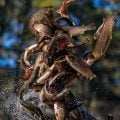How to Tie the Bronze Goddess
Producer: tightlinevideo
The Bronze Goddess is a remarkable smallmouth bass pattern that also happens to work incredibly well on trout. I’m pretty sure that both bass and trout mistake it for a crayfish because of its look, the movement of its materials, and the overall movement of the fly because of its Clouser-like dumbbell eyes.
The Bronze Goddess starts with a size 4 Mustard 9672 long-shanked hook. Because of the long shank, it’s imperative that the hook be firmly secured in the jaws of your tying vise.
For thread, I load what I’m told has to be called a bobbin holder, rather than a bobbin, despite the fact that every bobbin holder manufacturer calls their product a bobbin – with a spool of UTC 140 Denier in brown, not allowed to say Denier either. Unbelievable. Get the thread started on the hook shank behind the eye and, after taking a few wraps rearward, snip off the excess tag.
Although not absolutely essential, I’ve found that dubbing of virtually any kind really helps when it comes to firmly anchoring dumbbell eyes on a slippery hook shank. A small pinch is all you need to create a slender 2” long noodle on your tying thread. Take wraps with the noodle to build up a little cushion area right where the dumbbell eyes will sit.
For the eyes, I’m going to use small, lead presentation eyes—they’re heavy and they look good. Begin securing the eyes to the hook shank, an eye-length back from the back edge of the hook eye, with cross wraps of tying thread. I’ll then rotate my vise so the underside of the hook faces up. Pick up a small amount of super glue, here Fly Tyer’s Z-Ment, and saturate the dubbed tie-in area with it. Then, rotate the fly back to its original orientation. Next, I take yoke wraps with my tying thread which go over top of the eyes on either side of the fly, but underneath the hook shank. These are followed by circular flat wraps below the eyes, but above the shank, to pull everything in. The pressure of the wraps sets the Z-Ment in the dubbing to all but weld the eyes to the hook shank. No spinning here.
Brown marabou is traditionally used for the tail of the fly but this golden-brown stuff looks especially yummy so I’m going to use it here. I greatly prefer nice fluffy marabou, shown on the right, rather than the stringy, anemic-looking stuff on the left. Sometimes you can tear the stringy tips off of a marabou feather with your thumbnail and get reasonable results. Just don’t trim them off with scissors.
To prep a marabou feather for tie-in, strip off all the lower, shorter, misshapen and miscolored fibers. You want two feathers that are about equal in length and shape. I do like to tie the feathers in individually, so measure just one to a full hook in length then transfer that measurement rearward to the start of the hook bend. While keeping that measurement, tie the marabou feather to the near side of the hook. Secure it really well then snip off the excess stem. Now, measure the second feather to the same length and repeat the tie-in procedure on the far side of the hook. Tying the marabou in like this helps to keep the feathers vertical on either side of the fly. This is the kind of tail I’m looking for on a Bronze Goddess.
For a little shimmer, find the midpoint of three strands of copper Flashabou and secure it to the hook shank behind the eyes. Take rearward wraps behind the eyes to pin the material to the near side of the hook, all the way back to the base of the tail. Pull the forward-pointing portion of the Flashabou back and secure it to the far side of the hook. After making sure the material is bound down really well, end with your tying thread a little ways back from the dumbbell eyes. Trim the Flashabou off even with the tips of the marabou tail.
Copper-colored Estaz is used to create the body of the fly. I don’t want to waste a millimeter of this stuff, so I leave the material in the packet and get hold of one end. Secure the Estaz to the top of the hook shank, back to the base of the tail, then end with your tying thread a little ways back from the eyes. Start taking touching wraps forward with the Estaz to build up the body of the fly. When you reach your tying thread, use it to anchor the Estaz then snip the remainder off close, without wasting even a millimeter of the material.
Brown saddle hackle goes over top of the Estaz body, Woolly Bugger-style, a single feather is all you need. The fibers should be about a hook shank in length. Don’t even get me started on what I’m told I’m supposed to call the different parts of a hackle feather. Strip all the lower fuzzy fibers free from the stem and, with the shiny side of the feather facing you, strip a few more fibers from the upper side of the stem. This will help to ensure that the feather wraps correctly.
Keeping the feather in that orientation, lay the bare stem against the near side of the hook and take tight wraps of tying thread to secure it, then snip off the excess stem. With your tying thread behind the eyes, pull the hackle feather forward then give your bobbin holder a good clockwise spin to cord up, thin and strengthen your tying thread. Make rearward open spiral wraps with your tying thread through the Estaz, doing your best not pin down the frilly fibers in the process. End with a few wraps of tying thread right at the base of the tail.
Get hold of the hackle feather and start making open spiral, rearward wraps with it over top of the Estaz body. When you reach your tying thread, use it to anchor the feather and break or snip the excess tip off close. Now, make open spiral wraps with your corded up tying thread to cross-wrap the delicate stem of the hackle feather. Preen the fibers back behind the eyes and take a few wraps of tying thread to clean up the area.
A single mallard flank feather that’s been dyed wood duck gets tied in next. You want the fibers to be about a full hook in length and, ideally, the stem of the feather shouldn’t be too thick, as thick stems tend to split when wrapped. Strip off the lower, shorter, fluffy fibers from both sides of the stem. With the front side of the feather facing you, isolate it’s very tip by gently preening down the lower fibers, like so. You can then snip that tip off. While maintaining your grip on the feather, lay it against the near side of the hook and take thread wraps over top of the stem as well as a few of the swept-back fibers. This helps to reinforce the connection so the feather’s stem is less likely to break when wrapped.
Get hold of the lower end of the stem with hackle pliers then bend the stem down through the thumb and index finger of your left hand to fold the fibers rearward. Take wraps with the feather, preening the fibers back as you go. When you reach bare stem, anchor it with tight wraps of tying thread and snip the excess off close. Preen the fibers back and take a few wraps of tying thread to pin them back and to smooth out the tie-down area. When swept back, the fibers should extend a short ways down the tail of the fly.
Barred chestnut round silicone legs are used to add a bit of motion to the pattern. Rubber legs will do in a pinch. Two full-length strands are all you need. Find the midpoint of the strands and lay them against the near side of the hook. Take thread wraps to secure them there then pull the forward-pointing portion to the far side of the hook and anchor them there. As before, clean up the tie-down area with thread wraps.
Pick up the packet of Estaz once again and anchor the end to the top of the hook shank, then end with your tying thread behind the hook eye. Begin taking wraps with the Estaz around the shank and between the eyes, both top and bottom, to create a frilly little head on the fly. Anchor the material behind the hook eye and snip the remainder off close. Take a few more thread wraps to clean things up behind the hook eye then reach for your whip finish tool and use it to do a 5 or 6 turn whip finish, seat the knot well and snip or cut your tying thread free.
I like to trim the Estaz from around the eyes to make them more visible and trim any truly wonky-looking fibers from the head area. A drop of head cement, here Sally Hansen’s Hard as Nails, applied to the thread wraps will ensure they won’t come unraveled and enhance the fly’s durability.
And that’s the Bronze Goddess. She’s not the most elegant of flies but then again, beauty is in the eye of the beholder.
How to Tie the Black & Blue Bugger
How to Tie The Bugmeister











